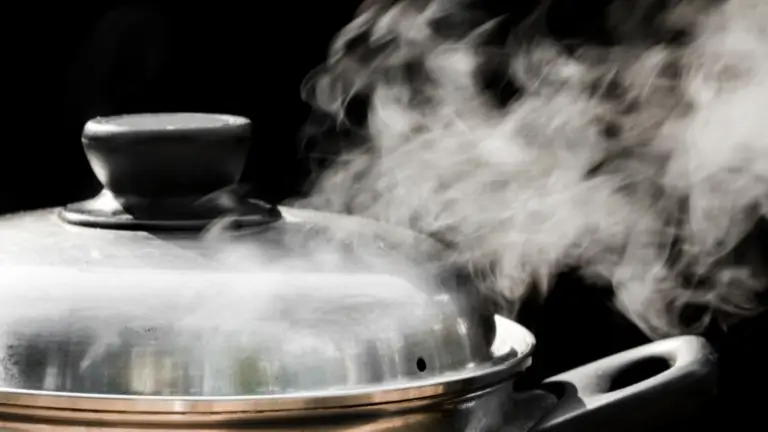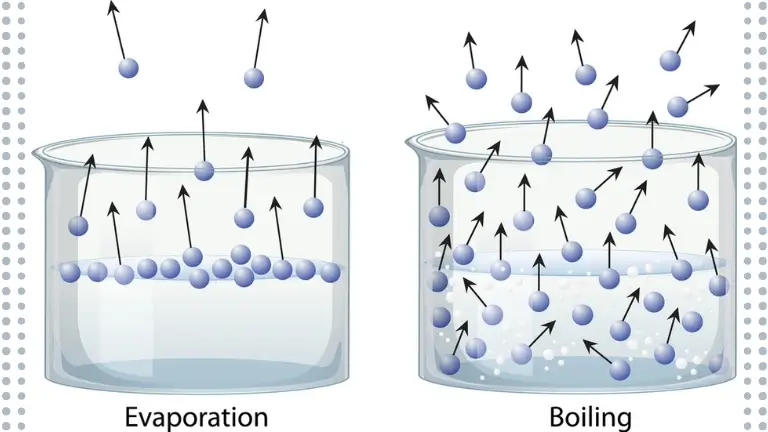In nature, vaporization and evaporation are two processes that frequently occur. These two processes are the natural causes of why we need to water our garden in the summer and why milk boils in a pot that is heated.
Both the terms “evaporation” and “vaporization” describe the transformation of liquid molecules into its gaseous phase.
The main difference between evaporation and vaporization is that a liquid’s evaporation occurs at a temperature below its boiling point. Whereas vaporization takes place at the liquid’s boiling point.
Let’s compare vaporization and evaporation by learn their definitions better understanding:
Table of Contents
What is Vaporization?

A process through which a solid phase transforms into a liquid phase is known as melting point. Vaporization is the method by which a liquid molecule turns into a gas due to adding heat.
While the movement of liquid particles increases in the liquid phase, they remain together due to strong intermolecular forces. As heat is added, however, a vibration of the particles becomes more and more dominant until it eventually takes over at the boiling point.
Liquids vaporize when heat is added, and the temperature is raised over the boiling point.
The transition from a substance’s liquid phase to its gaseous phase is known as vaporization.
Let’s now study the types of vaporization:
Two Types of Vaporization

There are two types of vaporization:
- Evaporation
- Boiling Point
1. Evaporation
It is a phase change of a state of substance or material below the critical temperature from the solid or liquid state to the vapor state.
A liquid changing its phase to become a gaseous phase is called evaporation. It happens when liquid molecules have enough kinetic energy to break out from the surface.
Evaporation always occurs on the surface at temperatures lower than the boiling point at a particular pressure. Therefore, water rapidly escapes and enters the atmosphere (no formation of bubbles or something.
Example: Evaporation can be seen when drying garments on a roof.
2. Boiling Point
Boiling temperature is the point at which the vapor pressure of any liquid equals air pressure, which can be either natural or artificial. A liquid eventually transforms into a vapor throughout this procedure.
Boiling is the formation of vapor as high-temperature water bubbles beneath the surface of the liquid, similar to how we keep the water jar on a high flame, which turns to bubbles, and then the steam escapes into the atmosphere.
It is also known as the phase transition from the liquid to the gas phase. Evaporation and boiling are comparable processes.
What is Evaporation?

A substance in a liquid condition moving to a gaseous phase due to a rise in temperature and pressure is known as evaporation.
You’ve possibly dried your clothes outside in the sun at temperatures that are, at their highest during the summer, between 40 and 45 degrees Celsius, well below the boiling temperature point of water. Have you ever wondered why water evaporates when our clothes are left outside in the sun? Evaporation occurs at temperatures well below 100 degrees Celsius.
Examples:
- Evaporation causes Rhodes to dry and lowers ponds and lakes’ water levels.
- As sweat molecules are removed from the skin, new sweat particles emerge and carry heat. This is why when you sweat, you may feel cold in front of a fan because sweat evaporates quickly, causing a rapid loss of body heat.
- Imagine you pour a drop of water on the floor and leave it there for some time …. after a while, you will notice that the liquid has disappeared, which means it is converted into vapor. This is the process of evaporation.
Learn more: What is the Difference Between Evaporation and Condensation?
What is the Difference Between Vaporization and Evaporation?
The differences between evaporation and vaporization are given below:
1. Conversion
The main difference between evaporation and vaporization is that evaporation converts a liquid to vapors at a temperature below its boiling point.
In contrast, vaporization converts a liquid to vapors at its boiling point.
2. Temperature
Another difference between evaporation and vaporization is that vaporization only occurs at a certain temperature known as the boiling point of the liquid.
While evaporation occurs at all temperatures with the potential for temperature change during evaporation.
3. Process
In a comparison of processes between vaporization vs. evaporation, vaporization is a quick and active process, evaporation is a quiet, slow process.
4. Liquid
In comparison between vaporization vs. evaporation, vaporization occurs throughout the liquid’s mass, as opposed to evaporation, which only occurs at the liquid’s surface.
5. Rates of Evaporation and Vaporization
Another evaporation and vaporization difference is that the evaporation rate is influenced by environmental variables such as the liquid’s surface area, wind, humidity, and temperature.
On the other hand, the vaporization rate is not affected by external variables like the liquid’s surface area, wind speed, or temperature.
Factors Affecting Evaporation Vs. Vaporization

The factors affecting evaporation vs vaporization are given below:
1. Factors Affecting the Rate of Evaporation
i. Temperature
The rate of evaporation increases as the boiling temperature rises. Because the molecules are moving more quickly at higher temperatures, it becomes possible that one of them will have enough energy to separate from the liquid and turn into a gas.
ii. Wind Speed
The rate of evaporation and wind speed are inversely correlated, meaning that as the wind speed increases, the evaporate rate also increases.
iii. Surface Area
The rate of evaporation increases together with the surface area.
The more surface area that is exposed to air, the easier it is for water molecules to absorb heat energy from the environment.
iv. Humidity
The relationship between humidity and evaporation is inverse. The rate of evaporation rises as the humidity falls.
2. Factors Affecting the Rate of Vaporization
i. Temperature
Vaporization and temperature are inversely proportional. The molecules’ have enough kinetic energy together with the temperature. The force of attraction weakens as a result.
Consequently, the rate of Evaporation increases as the temperature rises.
ii. Surface area
As the surface area grows and more particles are exposed to the temperature change, the vaporization rate also rises.
iii. Wind speed
As the wind drives away particles, the rate also rises with an increase in wind speed.
Differences Between Evaporation and Vaporization
Highlighting the main differences between evaporation and vaporization in the following table:
| Evaporation | Vaporization |
|---|---|
| Evaporation is the method of converting a liquid into a vapor at normal temperature. | The method of changing a liquid into a gas at a particular temperature is called vaporization. |
| Evaporation takes place at temperatures below boiling point. | When temperatures are above the boiling point, vaporization occurs. |
| Evaporation happens slowly which means it is a slow process. | Vaporization happens quickly which means it is a fast process. |
| Only the top layer of water evaporates during the process. | Every drop of water turns to gas during vaporization. |
| Only the liquid’s surface molecules vaporize during evaporation. | When a liquid boils and vaporizes, molecules may rise from below the liquid’s surface. |
Conclusion
While vaporization and evaporation are two related processes, they differ in key aspects that make them useful for various purposes.
The primary difference between evaporation and vaporization is that evaporation does not require any outside energy as long as there is a temperature gradient between the system and its surroundings, but vaporizing needs an external energy source to supply enough heat for the transition from liquid to gas.
Read more: What is the Difference Between Protein and Carbohydrates?


